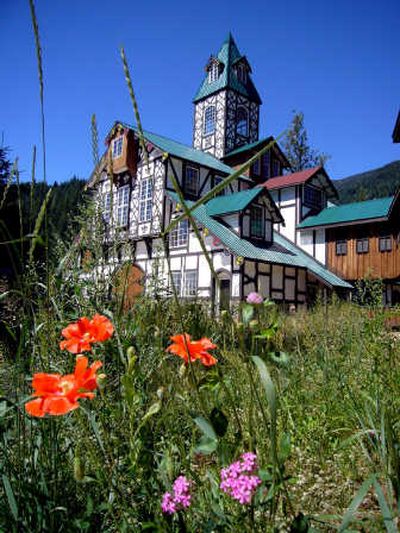Medieval for a modern life

HERON, Mont. – Deep in the Cabinet Mountains east of Sandpoint, a fairytale village is being hatched.
The design looks straight out of a Brothers Grimm story – half-timbered houses, a cobblestone square, slate roofs – and the vision behind the village seems equally far-fetched: No cars will be allowed, the dwellings will be about a quarter the size of most new homes, and those buying into the development will be expected to interact with their neighbors.
“Crazy, huh?” said the man behind the plan, Kree Kirkman, after describing his idea for the village.
The 50-year-old developer has already sunk $4.5 million into the site – only $56 million more is needed to pull it off. Kirkman knows the odds against him are as steep as the slopes of the surrounding Cabinet range, but he’s convinced Americans are ready to buy into this community, called Oberkleinberg after German words that roughly translate to “small hill.”
Kirkman is now trying to find corporate sponsors and individual investors in the village, recently granted nonprofit status. For a one-time payment of $20,000 or so, a buyer would be entitled to a week each summer at an apartment in Oberkleinberg. He doesn’t want people living there year-round, out of fear they eventually would retreat from the community by “sitting in their house, watching a big-screen TV and ordering out food,” he said while offering a tour of the site on a recent sunny afternoon. “Our village would cease to be socially sustainable.”
The village is designed to have about a dozen eateries, a church and a wide range of shops, including a creamery, blacksmith, print shop and tannery. Artisans and craftspeople will be part of the community and will be expected to rely on local materials and share their skills with other dwellers of the village. Residents will be able to buy ice cream cones, Kirkman said, but they will also be encouraged to milk the actual cow and learn how to make the ice cream.
“You’ve got to be involved,” he said, climbing the stairs to a seven-story barn tower that overlooks the village site.
Cars will be parked at the edge of the property or in a garage carved into the hill under the village. Transport between the village and several smaller outlying clusters of homes will be on foot or by horse carriage.
Oberkleinberg is meant to be something of an experiment, Kirkman said. “There is no working prototype, so I can’t say, ‘This is positively how it’s going to work.’ “
But Kirkman insists his vision isn’t aimed at only those who recycle gum wrappers or have wardrobes woven from hemp.
“It’s a place where you would want to go. It’s not like eating collard greens, where they’re good for you but nobody wants to eat them,” he said.
Kirkman came to these parts nearly a decade ago from Colorado. He was carrying enough money from his construction firm to buy 320 acres. He also was loaded with inspirations from his travels to 98 countries and every U.S. state but Alaska.
During his time abroad, Kirkman was inspired by the sense of community found inside walled, medieval German villages. The houses, shops and cafes are crammed together along winding, pedestrian-friendly streets, and the building materials stand for centuries. Back home in the U.S., however, most newer communities are characterized by huge houses, tall fences and wide, car-friendly roads. Kirkman, in fact, made his money building such subdivisions.
“I’m not anti-development,” he explained. “I’m not anti-anything.”
But Kirkman doesn’t think the modern subdivision is an ideal way to live. People don’t interact, he said. They shop in huge stores, drive long distances to their jobs and have little need to participate in the everyday affairs of their community. It’s this reality – as much as the quaint German burgs – that prompted Kirkman to move forward with Oberkleinberg.
“I’ve been looking for a place like this,” he said.
Paths and infrastructure already crisscross Kirkman’s acreage. Perimeter streets have been laid out. But the village site remains covered by trees. For now, all Kirkman has to show for his dreams are sheaves of paper plans and a massive barn and greenhouse. The buildings are rented out on weekends for weddings and other events.
Mostly, Kirkman uses the structures to showcase his seriousness to potential investors. The barn, for example, is built with massive, hand-hewn timbers and features a grand hall with thousands of hand-painted floor bricks and a vaulted ceiling covered by clouds. The light fixtures and even the door hinges were designed by Kirkman and hand-forged.
Sandpoint-based designer Pete Keller has been working with Kirkman to lay out the village and design some of its buildings. The project is unlike anything in the country, Keller said, but it draws on centuries of proven architectural traditions, including focusing homes on courtyards and common areas, rather than garages. Keller said Americans are ready for a return to the past.
“We’ve got all the technology we need, but what we don’t have are all these beautiful, well-built places,” he said.
By its nature, construction at Oberkleinberg will be sustainable, Keller said. Stone will be quarried on site, which will save fuel. The property also has loads of fir and larch trees for lumber. “The best way to build green – to build sustainable – is to build permanent,” said Keller, owner of the firm Designworks.
Building a self-sustaining, German-themed village in a remote corner of Montana seems implausible, Keller admitted, but he fully expects it to happen. Just don’t expect anything overnight.
“We’re planting an oak tree, not a jack pine,” Keller said.